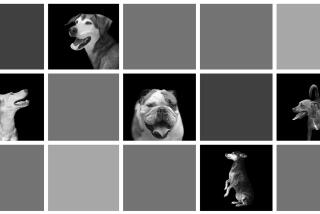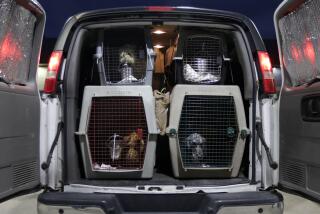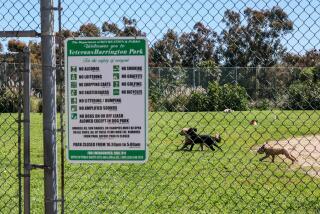Some ‘Superpower Dogs’ get the star treatment in a new IMAX film
Not all superheroes wear capes or have powers that enable them to leap tall buildings with a single bound or wield a heavenly hammer. Sometimes they just have cold noses and four strong paws.
But man’s best friend’s devotion to getting the job done, courage and empathy have saved countless lives, whether it’s rescuing survivors from disaster areas or helping war veterans with their psychological issues.
The new IMAX movie “Superpower Dogs,” opening Saturday at the California Science Center, follows six brave and accomplished canines:
— Halo, the runt of the litter of 10 Dutch shepherds, who becomes the new partner of Fire Capt. Cat Labrada of Miami-Dade County and a member of Florida’s Task Force 1.
— Henry, a border collie, who with his trainer, Ian Bunbury, form a senior avalanche rescue dog team in Whistler, B.C. Dog lover Chris Evans, who plays superhero Captain America, narrates the film in Henry’s “voice.”
— Reef, a 4-year-old Newfoundland who performs water rescues near Milan, Italy.
— Tony and Tipper, bloodhound brothers living in Lewa Wildlife Conservancy, Kenya, protecting the animal residents, including endangered rhinos and threatened elephants. So far the siblings have captured 40 poachers.
— Richocet, the film’s superstar, an 11-year-old golden retriever from San Diego who got on a surfboard with a young quadriplegic in 2009 and has surfed with hundreds of children and vets who have physical and emotional disabilities. She also works on land with veterans with post-traumatic stress disorder. Among her many honors are ASPCA dog of the year, the AKC award for canine excellence and inductee in the California Veterinary Medical Association’s Hall of Fame.
The same day the film opens, the California Science Center unleashes its companion exhibit “Dogs! A Science Tail.”
“Superpower Dogs” writer-director Daniel Ferguson, who had previously made the IMAX documentaries “Jerusalem” and “Journey to Mecca,” said casting with very important for “Superpower Dogs.”
Ferguson and his team decided to make the film’s core narrative a puppy’s journey from training to search and rescue certification. He had his researcher call FEMA contacts and search dog rescues.
As it happened, Labrada had just lost her 2 ½-year-old golden retriever partner due to acute kidney failure. She was flying from Miami to Michigan to pick out a baby Dutch shepherd.
“So I made some phone calls, and we all flew to Detroit,” Ferguson said. “The interview that you see in the film is the very first time I met Cat.”
Her selection of a puppy became very dramatic, because she didn’t click with any of the puppies. “Then Halo walked in the door,” said Ferguson. “She was the last one to walk in, and it was like the cliché scene of the femme fatale who walks in the door and just has this charisma and energy. Cat instantly clicked with her. She looked at me and said, ‘Are you seeing what I’m seeing? This dog’s amazing.”
Labrada said she was impressed with Halo’s strength and reaction time.
“She owned herself already at a young age,” she said. “That was very positive for me because they have to have — I don’t want to say courage — but they have to be comfortable in their own skin.”
Though Halo is certified, Labrada is still training her and has yet to be deployed with the dog “because I have other dogs that have been on the team that are older than her and have been training longer than her that should go out the door first.”
Ferguson first met Ricochet and his owner-trainer Judy Fridono at an outside table at a Starbucks in San Diego. “Ricochet was sitting down, very benign and not doing much,” he noted. “People were passing and going by and all of a sudden, she just looked up as if she got the odor of something and just left Judy’s side and walked right over to this man and just sat on his feet.”
Ferguson and Fridono walked over to the man, who told them, “You know I’ve got to tell you. Your dog makes me feel so much better. I’ve had a rough couple of weeks.”
“She’s a pretty incredible healer,” added Fridono.
Ironically, Ricochet was meant to be a service dog for people with disabilities. But at 4 months old, she discovered her love for chasing birds.
“She was a brilliant puppy,” said Fridono. “She was opening doors.” But then she decided to stop training.
Then Ricochet discovered surfing. “She was invited to a surf dog contest. She had only been in the ocean a couple of times, but she won third place at this contest. It was like a pivotal moment for me because for so long she did not want to do anything.”
Fridono decided to do a fundraiser at the beach for a 14-year-old quadriplegic boy who was a surfer and getting a lot of physical therapy. “I said, ‘They have surfing in common; let’s do a fundraiser for him.’ We went to the beach, and Ricochet was out on her board and Patrick was on his board, and they pushed them off. But at one point, she jumped off her board and onto Patrick’s. It was her idea. It was like the heavens opened again and she was reborn. She was so happy. I finally could see what she wanted to do.”
Ricochet, said Fridono, blows her mind. “I do not know how she does it. But it’s very powerful. She does a lot of healing and great work with the military. I look at her as being a very spiritual being. I think dogs live in a different realm. They are magical beings.”
The companion exhibit explores just how magical canines are in interactive displays that “let you see, hear and smell as a dog would,” said Jeffrey N. Rudolph., president and CEO of the California Science Center
Rudolph noted that he didn’t think they could do an exhibit about dogs and not have real dogs “because they are so special. So we’ll have live demonstrations of dogs from various worlds, showing rescue ability, agility, sensory service skills where they are canine companions or dogs training to do that.”
More to Read
Only good movies
Get the Indie Focus newsletter, Mark Olsen's weekly guide to the world of cinema.
You may occasionally receive promotional content from the Los Angeles Times.











